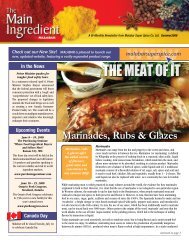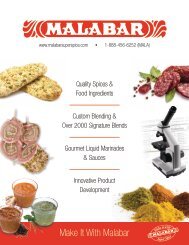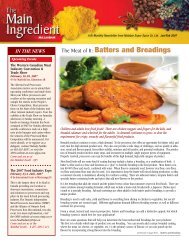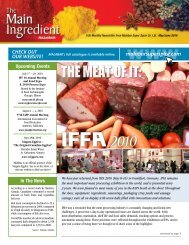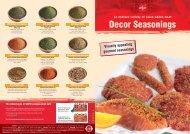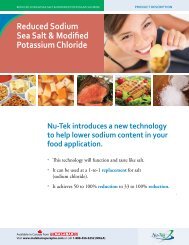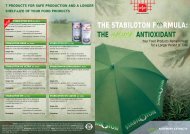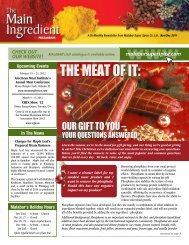The MeaT of IT: - Malabar Super Spice
The MeaT of IT: - Malabar Super Spice
The MeaT of IT: - Malabar Super Spice
Create successful ePaper yourself
Turn your PDF publications into a flip-book with our unique Google optimized e-Paper software.
A Bi-Monthly Newsletter from <strong>Malabar</strong> <strong>Super</strong> <strong>Spice</strong> Co. Ltd. Sept/Oct 2010<br />
Check out<br />
our website!<br />
Upcoming Events<br />
Registration for<br />
Food Processing Apprenticeship<br />
is Open!<br />
<strong>The</strong> Process Operator & Food<br />
Manufacturing apprenticeship program<br />
combines 10% in-class learning with<br />
90% practical, on-the-job training. <strong>The</strong><br />
program is very affordable for registered<br />
apprentices, while benefits to employers<br />
include more efficient and better-trained<br />
employees. <strong>The</strong> first course will be<br />
<strong>of</strong>fered at Conestoga College’s Doon<br />
Campus in Kitchener beginning in<br />
October 2010.<br />
For more information about<br />
registering an apprentice, contact<br />
Lisa McLean at 519.896.5967 or<br />
lmclean@a<strong>of</strong>p.ca<br />
<strong>Malabar</strong>’s full catalogue is available online.<br />
<strong>The</strong> Meat <strong>of</strong> It:<br />
www<br />
malabarsuperspice.com<br />
Oct. 31 – Nov. 3, 2010<br />
Pac Expo<br />
McCormick Place<br />
Chicago, IL, USA<br />
More than 1,600 exhibiting companies<br />
will be on hand in Chicago to showcase<br />
their latest packaging technologies<br />
on more than 1.1 million square feet<br />
<strong>of</strong> space.<br />
For more information,<br />
visit www.packexpo.com.<br />
In <strong>The</strong> News<br />
Organic foods are making a larger<br />
impact in consumers’ shopping choices<br />
in 2010, according to Whole Foods<br />
Market’s annual Food Shopping Trends<br />
Tracker survey. Twenty-seven percent<br />
<strong>of</strong> adults say natural or organic foods<br />
comprise more than one-fourth <strong>of</strong> their<br />
total food purchases this year, up from<br />
just 20% a year ago.<br />
Source: Statistics Canada<br />
For the L ve <strong>of</strong> Meat!<br />
As we settle into fall, the bulk <strong>of</strong> BBQ season behind us, and with Christmas<br />
coming fast, we at <strong>Malabar</strong> thought that it would be a perfect time to<br />
celebrate meat, in all its glory, with interesting meat ideas, trends and<br />
statistics.<br />
Meat Facts & Trends<br />
Convenience - Ready Meals are not a new idea, nor are we at the beginning <strong>of</strong> an upward trend.<br />
We are, rather, in the middle <strong>of</strong> this trend, with no end to the growth <strong>of</strong> this segment in sight. Canada<br />
accounted for 4.6% <strong>of</strong> new Ready Meal launches worldwide, and the U.S., 40%.<br />
Meat is Back! - Meat and Poultry consumption has been trending downward by roughly one percent<br />
per year per person on average for a while, however (in spite <strong>of</strong> all <strong>of</strong> the doom and gloom) 2010 saw<br />
a reversal <strong>of</strong> this trend! Canadians consumed 6% more beef, and 9% more pork than in 2009, while<br />
chicken and turkey consumption remained steady.<br />
Meat & the Marketplace - <strong>The</strong> food industry is the second largest contributor to Canada’s GDP, with<br />
Meat and Poultry accounting for $21.4 Billion in shipments in 2007. That is nearly double the amount<br />
<strong>of</strong> dairy products, and more than seafood, bread and bakery, and fruits and vegetables combined.<br />
continued on page 3
From the Lab<br />
What are Food Manufacturing/Processing Aids?<br />
<strong>The</strong> ingredient declaration <strong>of</strong> seasoning and spice blends <strong>of</strong>ten includes a few ingredients, at the end <strong>of</strong> the list, which are followed by the<br />
term (mfg aid). What does ‘(mfg aid)’ mean and how does it affect the ingredient declaration <strong>of</strong> the finished retail food product?<br />
<strong>The</strong>re is no regulatory definition <strong>of</strong> food manufacturing or processing aid in Canada. Canadian<br />
regulators have used “manufacturing aid” in an informal manner for substances used as adjuncts in food<br />
processing and manufacture. Most manufacturing aids are not mentioned in the Regulations. Like food<br />
additives, there is no regulatory requirement for preclearence <strong>of</strong> new manufacturing aids. But like all<br />
substances used in food, a manufacturing aid is controlled by section 4, part I <strong>of</strong> the Act - it must be <strong>of</strong><br />
suitable food-grade quality and safe for its intended use.<br />
<strong>The</strong> Food Directorate’s Definition <strong>of</strong><br />
Food Manufacturing Aid<br />
A food manufacturing aid is a substance that is used for a technical<br />
effect in food processing or manufacture, the use <strong>of</strong> which does not<br />
affect the characteristics <strong>of</strong> the food and results in no or negligible<br />
residues <strong>of</strong> the substance in, or on, the finished product.<br />
Common Manufacturing Aids and their function are:<br />
1. Calcium Silicate and Silicon Dioxide – act as anticaking<br />
agents to keep dry ingredients free flowing and to prevent<br />
hardening during storage. Usage level is between 0.5 – 1.0 %<br />
<strong>of</strong> the dry blend.<br />
2. Polysorbate 80 and Propylene Glycol – used as emulsifiers<br />
to make food flavours and extracts dispersible in water. Usage<br />
level is usually equal to the flavour compound, 0.1 – 1.0%.<br />
3. Vegetable Oils – used as an anti-dusting agent during the<br />
blending or manufacturing process. <strong>The</strong>y are also used to obtain<br />
a uniform distribution <strong>of</strong> ingredients, to prevent the separation<br />
<strong>of</strong> light or large particles such herb flakes from smaller, denser<br />
ground spice or salt. Usage level is 0.5 – 2.0% <strong>of</strong> the dry blend.<br />
It is important that a substance is appropriately identified as a<br />
manufacturing aid or as a food additive. “Food additive” is defined<br />
in section B.01.001 <strong>of</strong> the Regulations as any substance which<br />
becomes a part <strong>of</strong> or affects the characteristics <strong>of</strong> a food, but does<br />
not include:<br />
a) any nutritive material commonly sold as food<br />
b) vitamins, minerals and amino acids, other than those listed in<br />
Division 16<br />
c) spices, seasonings, flavouring preparations, and extracts<br />
d) agricultural chemicals, other than those in Division 16<br />
e) food packaging material<br />
f) drugs administered to animals that may be consumed as food<br />
Food additives currently permitted in Canada are listed in the tables<br />
<strong>of</strong> Division 16 in the Regulations at:<br />
http://laws.justice.gc.ca/eng/C.R.C.-c.870/page-1.<br />
html#anchorbo-ga:l_B-gb:l_16<br />
or those permitted for use through an Interim Marketing<br />
Authorization are listed at:<br />
http://www.hc-sc.gc.ca/fn-an/legislation/ima-amp/<br />
index-eng.php<br />
Labelling for Manufacturing Aids<br />
Manufacturing aids fall outside the regulatory definitions <strong>of</strong> “food<br />
additive” and food “ingredient”. As a result, manufacturing aids are<br />
not required under the Food and Drug Regulations to be declared<br />
on prepackaged food labels. Manufacturing aids differ from food<br />
additives and food ingredients in that they are not present in the<br />
finished food, or are present in a negligible amount.<br />
From further information<br />
http://www.hc-sc.gc.ca/fn-an/pubs/policy_fa-pa-eng.php<br />
<strong>Spice</strong> Market Update<br />
<strong>The</strong>re has been considerable volatility<br />
in the global spice market, with higher<br />
prices as a result <strong>of</strong> market shortages.<br />
Here’s what’s been happening:<br />
Black Pepper Market – <strong>The</strong> world pepper production this year<br />
is less than in 2009, but world consumption is significantly higher<br />
resulting in a mis-match between demand and supply.<br />
Nutmeg & Mace Market – Heavy rains in India have reduced the<br />
output <strong>of</strong> nutmeg and mace by 30-40%, while higher currency values<br />
for the Indian Rupee continue to push the market prices upward.<br />
Garlic Market – Prices started to rise sharply in spring 2009 because<br />
some people believed garlic could protect them from swine flu. At<br />
the same time, the amount <strong>of</strong> land devoted to growing garlic fell by as<br />
much as half because prices in 2008 had been lower than usual. This<br />
Capsicum Market – India is the largest producer <strong>of</strong> chillies and<br />
contributes 25% to the total world production, while being the largest<br />
consumer as well. <strong>The</strong> major market for capsicum is in Gunter, South<br />
India and May found it closed due to increases in mercury levels.<br />
As <strong>of</strong> June 2010, there was no more trading <strong>of</strong> capsicum from farm<br />
stock and trade is currently from cold storage supplies only. A lower<br />
Chinese crop <strong>The</strong> has information also increased provided demand is accurate on and Indian reliable chillies to the best with <strong>of</strong> all our knowledge, year but the is price <strong>of</strong>fered is solely on the for rise consideration, as an unusually without warranty cold spring or guarantee. has damaged<br />
factors contributing to market increases <strong>of</strong> more than 25%.<br />
the crop, and prolonged monsoons have delayed new crop production.
For the L ve <strong>of</strong> Meat!<br />
Meat & Health<br />
<strong>The</strong>re are numerous health benefits to eating meat, as it provides<br />
an excellent source <strong>of</strong> high quality proteins (more than a single<br />
vegetarian food is able to provide) and it contains all <strong>of</strong> the essential<br />
acids that the body requires.<br />
<strong>The</strong> iron in red meat, especially beef, contains heme iron, which<br />
is a highly usable form found only in animal products, and the<br />
absorption <strong>of</strong> the non-heme iron in meat is also enhanced. Including<br />
smaller portions <strong>of</strong> meat mixed with plant foods in your meal also<br />
enhances the absorption <strong>of</strong> non-heme iron from plant foods. Lean<br />
beef has 2.7 mg <strong>of</strong> iron per 100 g, and helps to generate red blood<br />
cells, as well as preventing conditions such as anaemia.<br />
Meat is rich in zinc (beef contains 4.1 mg), which is in charge <strong>of</strong><br />
triggering tissue regeneration, boosting metabolism, and is absorbed<br />
better than the zinc in grains and legumes. Pork and lamb also<br />
contain zinc and iron, but not in the same quantities.<br />
Lean meat is a major source <strong>of</strong> vitamin B12, niacin and vitamin B6,<br />
which help to maintain nerve cells and normal blood formation.<br />
Recent research has shown that eating lean beef, veal and pork is<br />
just as effective in lowering bad LDL cholesterol and raising good<br />
HDL cholesterol in your blood as is eating lean poultry and fish.<br />
As with all foods, moderation is important, with a focus on eating a<br />
balanced diet. Choose lean meat cuts, trim any visible fat, prepare<br />
the meat without adding fat, and eat reasonable portions. (Eating<br />
an entire 16-ounce steak in one meal is not a good idea!) Lean red<br />
meat, including beef, veal and pork can be part <strong>of</strong> a healthful diet.<br />
Meat from Many Cultures<br />
Meat plays an important role as a high protein food in most cultures<br />
and societies, and the variety <strong>of</strong> traditional meat dishes <strong>of</strong>ten depends<br />
on the climate and the history <strong>of</strong> the region.<br />
Meats from Canada - In Canada, traditionally the pleasure <strong>of</strong> eating<br />
game meat has been reserved for hunters and their families. Today,<br />
the farming <strong>of</strong> game animals provides high quality, succulent and<br />
tender game meat for everyone to enjoy. Game meat also <strong>of</strong>fers chefs<br />
and restaurateurs creative and delicious alternatives to just beef,<br />
veal or pork. A variety <strong>of</strong> game meats are now available in Canada,<br />
including bison, elk, red deer, caribou, moose, boar, muskox and<br />
rabbit. <strong>The</strong> combination <strong>of</strong> more lean body tissue, generally fewer<br />
calories, less saturated fat and significantly higher percentage <strong>of</strong><br />
cholesterol-reducing polyunsaturated fatty acids makes game a hearthealthy<br />
choice. Menus may include panseared bison ribs or wild<br />
boar prosciutto.<br />
continued from page 1<br />
Canada is especially well suited to raising game meat and there<br />
are many meat processors with game meat available. Black Angus<br />
Meats (with stores in Mississauga and Thornbury Ontario – www.<br />
blackangusmeat.com) provides an extensive list <strong>of</strong> wild game meats,<br />
including bison, caribou, elk and also kangaroo. Hills Foods Ltd in<br />
Coquitlam, BC <strong>of</strong>fers unique protein alternatives, and was especially<br />
proud when they supplied Culinary Team Canada with the wild<br />
Arctic muskox that won the team a gold medal at the Berlin Culinary<br />
Olympics in 1996.<br />
Meats from Africa - In Africa, the requirement for longer shelf life<br />
is met by drying the meat, with products such as Biltong or Kilishi.<br />
In West Africa they have a processing method where large pieces <strong>of</strong><br />
meat are hot smoked in dense smoke and at high temperatures.<br />
Meats from Asia - <strong>The</strong> tradition <strong>of</strong> meat processing in Asia,<br />
especially China, is much older than in Europe. <strong>The</strong> Chinese Sausage,<br />
(called kunchiang, yuen chang or lup-cheong) is made from fresh<br />
pork and cubed pork fat with curing salt, sugar, pepper and garlic<br />
added (additional ingredients may include cinnamon, ginger, soy<br />
sauce and Chinese rice wine). Sugar is added at levels ranging from<br />
2 – 6%, and may be as high as 10% with the consideration that the<br />
higher the sugar content the better the microbial stability due to the<br />
lowering <strong>of</strong> the water activity (aw).<br />
Spleen-liver sausage is a unique product made in South-East Asia,<br />
and includes the <strong>of</strong>fals, liver and spleen only, which are minced and<br />
then mixed with 10% garlic, and sometimes rice, salt and spices.<br />
This sausage is air dried and its high garlic content prevents spoilage.<br />
In North-East Thailand you will find the Herb sausage (Isaan<br />
sausage) which is made with coarse ground pork, 20% fat and a<br />
variety <strong>of</strong> herbs including lemon grass and bergamot leaves.<br />
Offal: <strong>The</strong> Forgotten Meat<br />
What about the <strong>of</strong>fals? Offal is a culinary term used to refer to<br />
the entrails and internal organs <strong>of</strong> a butchered animal. Another<br />
reference would be the innards – tripe, liver, gizzards, hearts<br />
and brains. In countries like France and Spain, these ingredients<br />
frequent the most elaborate dishes; in England, they form part<br />
<strong>of</strong> the hearty and homey meals. You will find liver sausage,<br />
headcheese and blood sausage in many European delicatessens,<br />
but you will not find <strong>of</strong>fals in the larger supermarkets, or in<br />
most restaurants.<br />
For an interesting (and<br />
popular!) restaurant that serves<br />
<strong>of</strong>fal, head to the “Black Ho<strong>of</strong>”<br />
in Toronto (928 Dundas St.<br />
W.) where smoked and cured<br />
meats are featured and enjoyed,<br />
and the menu includes pickled<br />
lamb tongue, crispy pig ear and<br />
roasted bone marrow.<br />
Yes, meat can be<br />
interesting, delicious<br />
and nutritious too!
Blends <strong>of</strong> the Season<br />
To celebrate the variety <strong>of</strong> meats & tastes in Canada, we bring<br />
you a selection <strong>of</strong> interesting, diverse & exotic flavours - just<br />
right for your customers’ table this autumn. Enjoy!<br />
Game Seasoning<br />
#RA00590<br />
With hints <strong>of</strong> juniper berry and cloves this<br />
seasoning enhances game meat flavour & is<br />
recommended for all types <strong>of</strong> game dishes.<br />
Jambalaya Sausage Binder<br />
MALJUM-270<br />
A colourful, piquant seasoning full <strong>of</strong> vegetable<br />
pieces for visual and textural appeal.<br />
Jalapeno Wild Game<br />
Seasoning & Binder<br />
MALJBB-030<br />
This seasoning is spicy, with jalapeno flakes<br />
and a hint <strong>of</strong> mequite smoke.<br />
Piri-Piri Sausage Seasoning MALPIR- 911<br />
Bird’s eye chili heat balanced with a sweet touch<br />
<strong>of</strong> citrus and fragrant coriander. This seasoning<br />
is designed for a cured, cooked sausage.<br />
Chimichuri Fresh Sausage Seasoning MALCHIM-222<br />
A fresh, flavourful combination <strong>of</strong> green herbs,<br />
lemon and crushed chillies.<br />
To Order a Sample <strong>of</strong> any <strong>of</strong> the above or if you have a new<br />
flavour you’d like to try, contact us at 1-888-456-6252, or<br />
email lab@malabarsuperspice.com<br />
Did You Know?<br />
Australian scientists have found that people who ate a diet high in<br />
protein, based on lean red meat, as well as fruits and vegetables,<br />
lost 25% more weight over a fixed period <strong>of</strong> time than those who<br />
ate a low protein, carbohydrate-rich diet that contained the same<br />
amount <strong>of</strong> calories and fat.<br />
OUR PRESIDENT’S<br />
Message<br />
I grew up in a home that celebrated meat, and it was included in<br />
every meal. My father came from Germany, as a sausage maker,<br />
and my Oma also had a butcher shop in Germany.<br />
Both loved to cook, so spices, garlic and pork fat were common<br />
ingredients in our house. I have very fond memories <strong>of</strong> cooked<br />
pork fat thickly smeared onto rye bread, fresh lean beef tartare<br />
(with chopped onion, salt and pepper) every Saturday for lunch,<br />
and dinners that included vegetable soup with pigs feet and pork<br />
hocks, or beef tongue with boiled potatoes.<br />
Unfortunately over the years, many <strong>of</strong> these dishes have become<br />
nearly extinct here in Canada (with changes in consumer<br />
preferences, and also increased government regulations that make<br />
processing them more onerous). So it is with anticipation when I<br />
visit Germany at least once a year and I am welcomed with tartare,<br />
bloodsausage and pork hocks (in moderation <strong>of</strong> course)!<br />
Did You Know?<br />
Sincerely,<br />
Doris Valade<br />
President<br />
<strong>Malabar</strong> <strong>Super</strong> <strong>Spice</strong> Co. Ltd.<br />
Falling prices provided grocers the opportunity<br />
to feature meat & seafood at significant<br />
discounts and consumers responded<br />
enthusiastically. According to Nielson<br />
Canada, 35% <strong>of</strong> all retail meat & seafood<br />
purchases were made at temporary price<br />
reductions (TPR) between fall ’08 and fall ’09,<br />
up from 30% the year before.<br />
No other grocery category derived a greater portion <strong>of</strong> its sales<br />
from TPRs in the recession.<br />
From the Food in Canada<br />
2010 Canadian Food Industry Report<br />
For more information on any <strong>of</strong> the subjects covered in <strong>Malabar</strong>’s newsletter, or to suggest topics you’d<br />
like to see covered in future editions, please contact Sara Alexander at marketing@malabarsuperspice.com.<br />
Look for our next edition in Nov/Dec 2010.<br />
<strong>Malabar</strong> <strong>Super</strong> <strong>Spice</strong> Co. Ltd., 459 Enfield Road, Burlington, Ontario L7T 2X5 www.malabarsuperspice.com<br />
<strong>Malabar</strong> is certified to provide both<br />
Kosher and Halal products, and is<br />
proud to be HACCP accredited.<br />
<strong>Malabar</strong> takes your privacy very seriously, and we do everything in our power<br />
to safeguard it. We NEVER rent, sell, lend or otherwise circulate our mailing<br />
lists or other contact information to anyone outside <strong>of</strong> <strong>Malabar</strong>.



